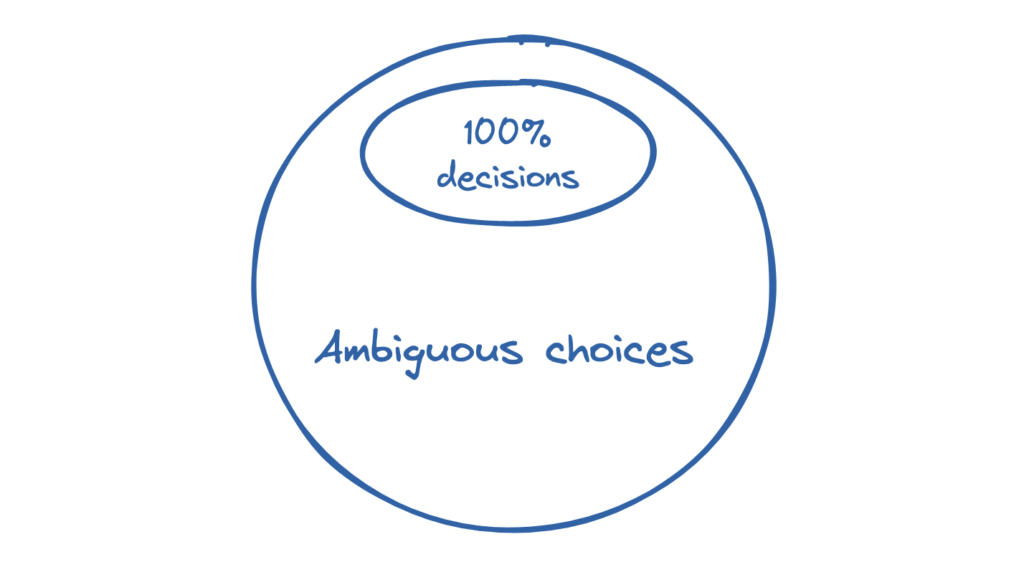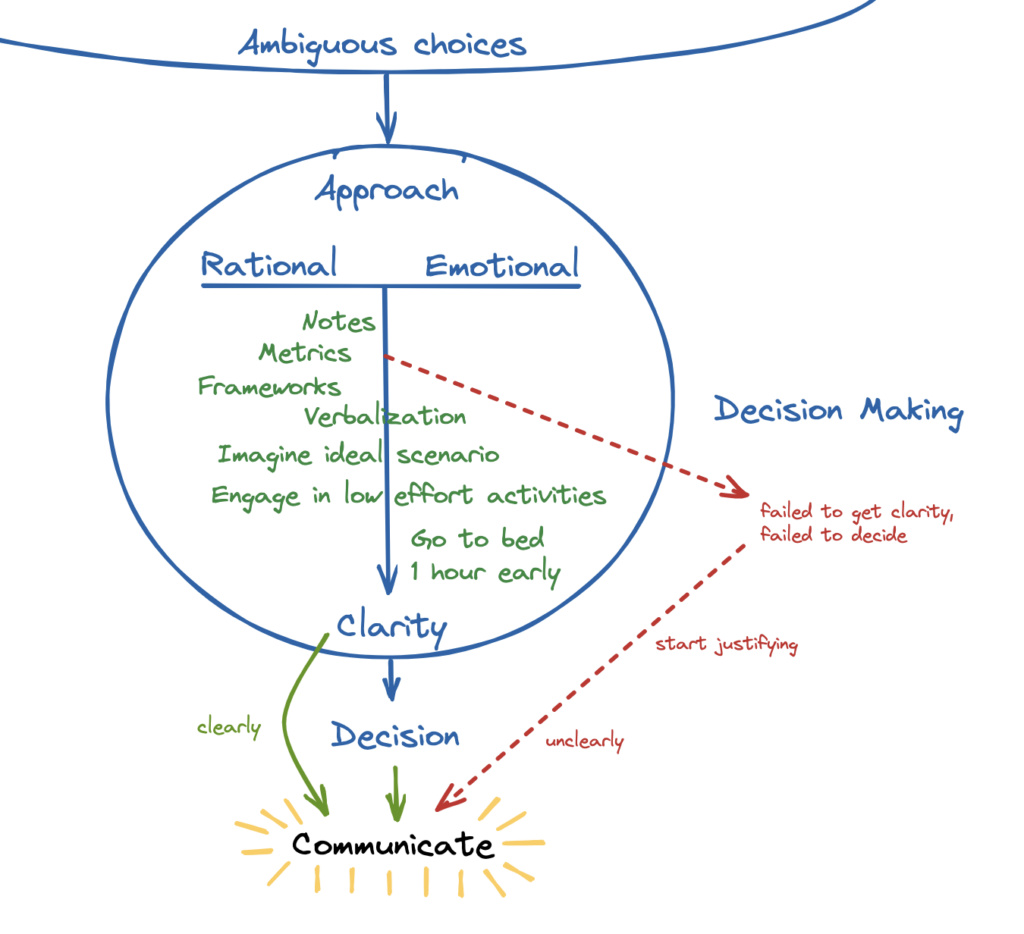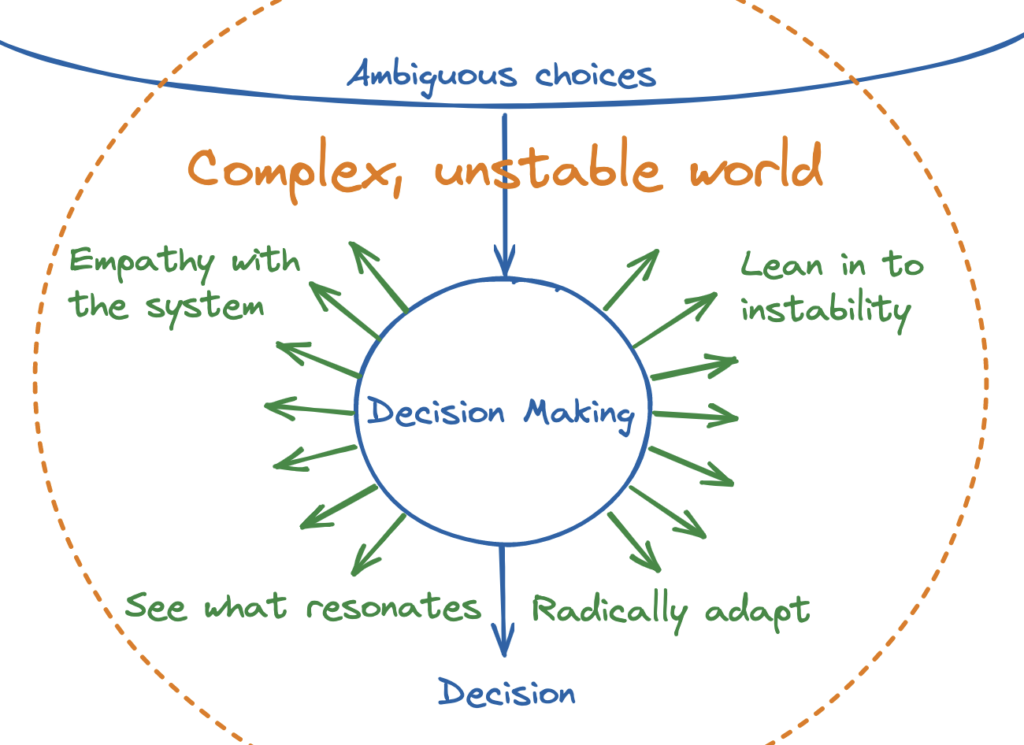
Decision-making in a complex, unstable world
100% Decisions vs Ambiguous Choices
In the realm of decision-making, we encounter both clear-cut choices and more challenging dilemmas. While 100% decisions – those with an obvious answer – are relatively rare, they provide a comforting sense of certainty. For example when we’re offered a tasty meal for an inexpensive price. Or when an incredibly interesting job opportunity comes along. Or when we find our dream apartment and it turns out they’re happy to rent it to us, plus it’s affordable. With decisions like these, of course, we’re going for it. To me, a good indication for a 100% decision is when it looks like a 90% decision in advance.

However, it’s the ambiguous choices, where the best path forward isn’t easily visible, that we’re encountering most of the time. Should I go drinking tonight with a light fever? Is taking up a semi interesting side job a good idea? Will it be safe to launch with a paraglider in these windy conditions? In these instances, striking the right balance between rational analysis and gut feelings becomes crucial.
Rational vs Emotional
A friend recently asked me how I’d go about choosing which job to pursue. So I explained that I had tried a rational approach. I had come up with the following metrics to rank an opportunity:
- interesting people to work with
- tech skills to learn
- communication skills to learn
- place & time flexibility
- degree of ownership of the results
- compensation
- overall sense of future potential
For each of the metrics, I would assign numbers from 0-5, count the total sum, and compare the sums between the jobs. It felt like a solid, rational approach, until I realized, that I kept coming back and correcting the numbers. The reality of a job rarely matched my estimations (in both positive / negative directions). Did a purely rational decision-making approach fail to fit the choice at hand, or could refining the approach through iteration help reduce estimation errors?
I’m not much wiser today, but in this case my verdict is to follow the mantra
Plans are useless, but planning is essential
The mere practice of following the rational approach helped me seriously consider every one of the criteria.
However, in a world that prioritizes rational decisions, emotional decision making can serve as a valuable complementary tool. Trusting our intuition allows us to tap into a unique source of insight, guiding us towards the right choices for reasons that we might not quite be able to articulate at that point in time.
An example for when that worked out for me was moving from a bigger to a smaller city. I didn’t know exactly why at the time, but besides all rational considerations, it just felt like the right thing to do. And I’m glad I listened to myself.
I’d argue we – and especially those of us in engineering disciplines – should be listening more to our gut feelings and re-learn to trust relying on them. For me, getting enough sleep contributes significantly to a fine-tuned intuition that’s ready to meet the challenges of the day. To the point where I might say to myself:
Plans? Nah, let’s just go! I prefer situations!

Eventually, the most holistic approach seems to me to try and reach for both rational and emotional decision making methods. When we’re aware of our own bias – whether we default to making decisions more emotionally or more rationally – it becomes easier to try and balance that out a bit. For me, I’d like to follow the mantra:
Do what you think is right, but if it doesn’t feel right, don’t do it
Now the decision making approach is one thing. But how do we start the process? How to make the choice? And how to communicate it clearly?
Decisive Choices and Effective Communication
The same friend who asked me how to make good decisions, said: Kai, you seem to be making clear decisions, how do you communicate them? Especially, how do you avoid being unsure, how to stop answering prompts for justification?
First of all, I felt humbled that it seemed like I was making clear decisions. The truth is, I’m often not making clear decisions at all. I leave projects hanging, neither committing to continue, neither deciding to end them, and I end up in stalemate situations. At the time of writing, the state of Gliderbase.com is one example. Often, I also just don’t communicate proactively enough.
But the times when choosing and communicating do work out well for me, the process is this:
- I’m verbalizing the topic, either talking to myself or to someone else, structuring thoughts.
- An image of a kind of ideal scenario starts forming in my head. I almost start seeing the world where I’ve made that decision.
- Then I process everything until the whole picture becomes clear enough. Clarification often happens automatically, when I’m engaged in a low effort physical activity (showering, cooking, laundry, cleaning) without mental distractions like music or podcasts.
- In case I still can’t make up my mind, my top-secret method is going to bed 1 hour early, lying awake and giving my brain time to think.
- Once I’m clear on what I want, and on what I’ve decided, communicating clearly becomes just saying directly and honestly what I’m thinking.

Sometimes, people ask for clarification. That’s fine and I’ll try my best to clarify. Other times, people ask for justification. Those prompts, I’m trying my best to ignore. From what I’ve learned so far: the important people respect a clear statement, and start working with it, instead of asking for justification.
To summarize: once we have clarity about what we want, once we have firmly decided, it becomes easier to be confident and precise in our communication. This also leads to smoother negotiations, because we can focus on the conversation partners, instead of on ourselves. Then the clarity in communication creates trust as well.
So if I’m unclear about what I really want, if I haven’t decided yet, it’s too early to communicate clearly. I like to remind myself of what Herfried Münkler said (German):
Wer im Modus des Schwitzens denkt, verliert ein strategisches Spiel
Empathy in Unstable, Complex Systems
The choices we make as individuals today hold more weight than ever. With the world moving fast, the consequences of our actions are becoming increasingly unpredictable. Today, nobody reads our tweets, tomorrow we hit virality. Today we’re a social media influencer, the next day we’re canceled. Today we’re launching a marketing campaign, tomorrow something unexpected happens, and suddenly how we phrased it makes us look completely out of touch. Today, our product finds customers, tomorrow there’s a paradigm shift and what we’ve built seems obsolete. How can we make good decisions in unstable times like these?
I never really knew a good answer, so as a compass for decision making, I just kept reminding me that
If we lose everything, all we’re left with is who we know and what we’re capable of.
So very broadly, the instability of the world makes it more advantageous to focus on building skills and relationships rather than accumulating possessions.
But I learned something new on the topic when I skimmed through Peter Kruse’s book next practice. The book explores how to navigate different types of systems. Kruse categorizes systems into four quadrants along two axes: simple vs. complex and stable vs. unstable.
- Simple and stable systems are easy to control, since we always know how they will react to an action.
- For simple, unstable systems, trial and error is the best approach to follow. Some of our actions might be met with unexpected reactions, but there’s a possible progression by ruling out what didn’t work.
- Complex and stable systems, like traffic, can be managed by introducing regulations and boundaries to incentivize the actors in certain ways.
- The systems we have the hardest time navigating well are those that are both complex and unstable, like financial markets, the economic system, geopolitics, and social media networks.
For complex and unstable systems, Kruse suggests leaning into the instability and carefully trying out different approaches, as what may have looked crazy yesterday could be completely viable today. In such systems, our big decision from last week may need to be revoked, because the circumstances have completely changed again. The key is to try and empathize with what currently resonates in the system and to be ready to adapt more radically than we intuitively would.

What remains is the mantra
All of our actions are risky, but we can’t afford not to act
All rights reserved.

